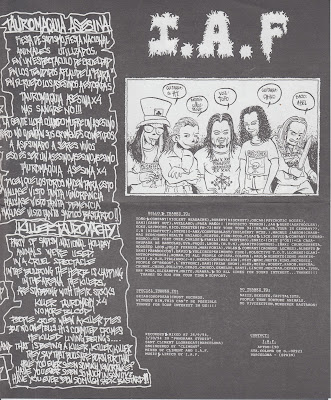 |
| Nice carpet underneath, isn't it? |
First things first: they picked a cracking name. I absolutely love it as it can mean a lot of different things in terms of representation and metatextuality (were Effigy an effigy of crust?) and it works all the better for Japanese bands, since they are really keen on referentiality and band-worship, sometimes excessively (remember that SDS were supposedly "the ghosts of Antisect"). And let's face it, the name "Effigy" sounds super cool. It may sound trivial, but it matters nonetheless. The trio formed in 1998 and were from Takamatsu, on the Shikoku island. I couldn't find any information about potential pre-Effigy bands so it might have been their first shot, although, given the high level of accurate punk references, even on their first work, I personally doubt it. But then, I am not an endless well of knowledge when it comes to Japanese punk.
I would tend to think that Effigy were not exactly from the same generation as the crust bands who were already established by 1999, like AGE or Abraham Cross, not to mention old-timers like SDS or Gloom. But Effigy were a few years earlier than the metal-crust revivalists like Zoe, Disturd or Acrostix, bands they are often associated with through their common crust background or through their respective records on Crust War. Were Effigy in-between both generations? Or perhaps the wave dynamics didn't have as much effect on Effigy because of their specific location? The fact is that Effigy don't really sound like their elders, although, of course, they sound like a Japanese crust band (but has there ever been a Japanese crust band that doesn't?). But I don't hear any real, tangible SDS influence, especially in terms of song-writing and production. There are a few riffs that could remind one of SDS, but they don't intend to have the same cold slickness as Antisect-era SDS or the same controlled and focused fury as their latter period. One thing they certainly shared is the obvious Antisect influence, but they didn't translate in the same way. Where SDS intended to rework the sound and the atmosphere of Antisect's songwriting, Effigy basically "japanized" Antisect riffs, meaning they played them with more over-the-top metal energy.
Undeniably, Effigy's influences had more to do with Antisect, Hellbastard, early Axegrinder with a touch of early black and doom metal than with the local crust production, which was the case of most Japanese crust bands at the time and the gloriously obsessive "Doom-Throat" approach of Abraham Cross attested to that. To be fair, it is pretty easy to spot Effigy's models. Their 2004's split 10'' with Hellshock contained two unashamed borrowed songs from Antisect ("Choice of darkness" is actually a slightly reworked intro that Antisect used to play in 1987) and Bathory. And I have to confess something here: I knew Effigy before I did Bathory. I know it may sound weird, but I have never been into proper metal and at the time, classic extreme metal bands weren't really appealing to me. And I thought that the riff on "The day the Devil reigned" was fantastic! How flabbergasted was I when I finally discovered that it was pretty much an undeclared Bathory cover...
Anyway, this 12'', "Evil fragments" was Effigy's first record and despite some sloppiness, a production that lacks crunch and an overall feel of incompletion, I think it is still a pretty solid, enjoyable effort. The four songs sound like a Japanese crust take on late Antisect and "Ripper crust" era Hellbastard with great over-the-top dual vocals only the Japanese know how to pull out. The beat is mostly fast, but there are enough groovy metal breaks to keep things old-school. And, to end "Evil fragments", they used the same tune as Concrete Sox on the intro to the "Your turn next!" Lp, which is both a little odd and lovely. It is not Effigy's best work by far, the "From Hell" Ep that Crust War released in 2003 is their defining moment but it definitely pointed in the right direction and I would argue that it may have triggered some renewed interest in the classic UK crust bands in Japan. And maybe even in Portland. The dudes in Hellshock had probably been listening to the Peaceville sound for years, but Portland being Portland, Japan is pretty big over there, so to speak. More than bands like Misery or Extinction of Mankind, a band like Effigy, with overt UK crust influences, might have ignited the idea to do a project along the same lines in Portland. I am not saying that the day after one of the blokes listened to Effigy, they started Hellshock, but it might have played a part. Or not.
Effigy got better and better time passing, the split Ep's with Äpärät and Häväistys showed definite improvement and the aforementioned 2003 Ep was their crowning glory. I would love to say that the split with Hellshock was brilliant but I have always felt a bit let-down by it, probably because of the very high expectations I had at the time. And then, there is that Bathory story that will make me feel like a fool for eternity.
After the end of Effigy, Kakuda, the drummer, played in Axewield, a band that tried to fuse doom-metal with the Effigy recipe but that I never really got into. He recently joined Disturd and plays on the new album, entitled "Dark". I have only listened to it twice but let me tell you that I am really loving it so far. One of 2015's best crust albums and hopefully one that will inspire a new generation of Japanese punks to work on these terrific Antisect riffs...






































